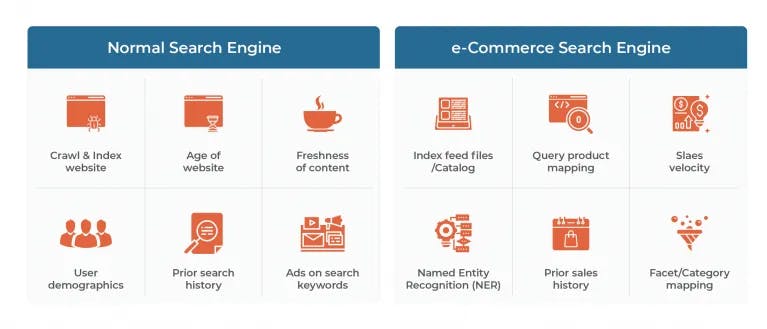Importance of an effective ecommerce site search engine
In today’s world, customers’ expectations are very high when visiting any ecommerce website. They want to find their required product quickly and efficiently.
Generally, on average, the following behavior is overserved for customers using site search:
- 10% — 15% of site customers utilize search on the site
- 30% — 40% of site transactions and revenue come from these customers
- The average conversion rate (CVR) of these customers is 3–5 times compared of regular customers
- The average order value (AOV) of these customers is 25% to 50% higher than regular customers
From the above facts, we can observe that an ecommerce site with an effective site search has the upper hand compared to websites not having one.
Benefits of an effective internal site search for customers
Reduces friction in the search experience
Effective internal search enables a streamlined and more efficient search process for customers to get to the required product(s) quickly by reducing the touchpoints.
- Provides better relevance for each query
Most of the time, customers get overwhelmed by an overabundance of vague or off-target search results, too few, or, in some cases, no results at all, an effective site search improves the experience of a customer by providing precise and relevant results.
- Improves UX for customers
An effective internal site search enhances the user experience by providing intuitive facets and filters to filter and giving them the capability to sort and filter products based on personal preferences and requirements.
Benefits of an effective internal site search for companies
Increases customer retention on the site
Generally, the retention rate is 2–3 times higher for an ecommerce site with an effective site search than a website without one.
Uncovering customer intent
One of the main challenges for an ecommerce site with diverse categories is a lack of visibility into or understanding of what customers are looking for; a practical internal site search function can give a company a direct line to this information.
Improves product discoverability
Another primary challenge for an ecommerce site with diverse categories is product discoverability due to huge catalog sizes across varied product categories; a practical internal site search function improves product discoverability by helping customers get their required product(s).
Difference between ecommerce internal site search and standard search engine
Intent
While all search queries entered on regular search engines are intended for a quick and desired response. On ecommerce, the customer intends to search for products to buy.
- Algorithm
The complexity of algorithms that run behind typical search engines needs to understand human language and respond typically for every query entered. Ecommerce search engines work with just one factor in mind: “show products with their ability to sell,” the better a relevant product is shown, the better is its possibility to sell.
- Core ranking factors
A regular search engine ranks and optimizes a website to increase its click-through rate on the Search Engine Results Page (SERP). Ecommerce sites rank products based on ‘Sales,’ including Conversion Rate, Keyword Relevance, and Customer Satisfaction.

Different elements involved in the backend to show relevant results for both types of search engines.
7 Elements of an effective internal site search mechanism
- Prominent placement and functional design of the search bar: ECommerce should put the search bar in central areas on a site, that is, the top right corner or top center of the page, to improve accessibility and usability.
- Provide relevant search results with balanced recall for a search query: The most crucial component of having an effective site search is providing relevant products for a search query while maintaining product recall (number of products shown on the Search Result Page (SRP) of a query).
- Have an effective ranking system: Effective ranking of search results is essential for showing relevant search results. ~90% of customers don’t go beyond the first page of an SRP, so it is imperative to showcase the top-selling/top-rated products on the top.
- Offer autocomplete option in the search bar: Including an auto-complete option in the search bar is another effective way of making the search experience smoother and more accessible for customers and improving UX.
- Provide synonym results for search queries: Many of the products/categories on the site can have multiple synonyms, like “sofa” and “couch” have a similar meaning, so providing search results for synonyms helps in improving conversion by providing a more extensive set of results on the SERP.
- Provide the “Did you mean” option for typos: Shoppers often get zero search results when they don’t spell the product name correctly, so showing ‘Did you mean with alternative results to the search query will make sure they find products for their intended search query.
- Provide alternate results for queries with very low recall, or zero results search queries: Many of the long tail/exact search queries like “Nike Zoom 7000 Running Shoe” may have zero relevant results due to multiple reasons like being out of stock or exclusive availability on a site. In such cases, providing alternate results with similar products will help retain customers and improve UX.
Additional elements of an effective internal site search mechanism
- Provide effective filtering/sorting option in search results: Another component of an effective site search is to provide the opportunity to filter/sort search results based on price, category, size, color, etc., while maintaining the search relevancy of the query.
- Provide curated search landing pages: Providing curated landing pages for top queries like “Nike” or “iPhone” on a site increases the user experience and helps cross-selling and upselling.
- Provide personalized experience: In today’s competitive ecommerce business showing personalized results has become a key component to improving conversion. Personalization can be based on factors like region, brand affinity, price range, etc.
- Provide multi-lingual search: In countries like Canada and India, where multiple languages are spoken across the country, providing multi-lingual search support helps reach a broader customer base.
- Have an effective feedback loop: Providing a better UX on an ecommerce site is vital to have an effective feedback loop to improvise search algorithms and search settings.
How Named Entity Recognition (NER) makes search results more relevant on an ecommerce website?

Example of Named Entity Recognition (NER) usage on an ecommerce website:
- In simple words, NER helps understand the intent of a search query as it is very challenging to understand the real customer intent behind a query due to the varied products on an ecommerce site.
- For example, in the above search query “red check casual dress for women,” NER can help us identify that red is a color, check(s) is a pattern, casual is a style, the dress is a product type,, and women is gender.
Conclusion
We can conclude that an effective internal site search system with algorithms like Named Entity Recognition (NER) and dynamic ranking of products can help an ecommerce company show relevant products for any search query by knowing its true intent. Any ecommerce company would benefit from it. It helps them increase revenue by offering customers products they want to purchase, improving the user experience, and retaining more customers. If you're going to boost your income, book a demo with us.







